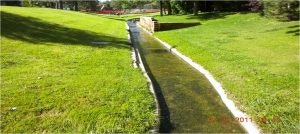Activies that are NEVER allowed in the Floodplain

Use Factors: In general any use that has potential for the following to occur is prohibited in the floodplain:
- Obstruction (e.g.. Fill) of the flood water flow so that the floodplain is altered in elevation and extent in excess of the allowable criteria (unless approved through a floodplain modification study).
- Reduction in the carrying capacity of the channel (unless approved through a floodplain modification study).
- Storage of materials, equipment, or facilities that could become dislodged or displaced and /or deposited downstream causing culvert or bridge blockage, channel degradation, or damages to other properties.
- Activities that negatively impact water quality.
Prohibited Uses. The City has determined that the following uses are prohibited within the floodplain:
- All new construction of structures including residential, non-residential, recreational.
- Fill in the floodplain for the purpose of obtaining a CLOMR-F/LOMR-F for future site development.
- New construction of critical facilities.
- Additions to existing structures.
- Permanent fencing, including solid or perforated wood, split rail, chain link, stone, brick and/or other materials.
- New construction of landscaping walls or structural walls that extend or flatten land that result in floodplain encroachment.
- Storage process of materials, or any other activity that may have an adverse impact on water quality.
- Storage or processing of materials, which are buoyant, flammable, explosive, or could cause injury to humans, animals, or plants.
- New construction of streets
- Permanent toilet facilities.
- New construction of structures, ponds, or appurtenances related to water and wastewater treatment facilities.
- Parking lots in the floodplain fringe are prohibited unless it is associated with an approved floodplain use such as recreation facilities/parks where the use is for a short period of time.
- Detention or water quality ponds not part of a regional or approved drainage master plan.
Storage of Materials. Storage of hazardous or floatable materials in the floodplain is prohibited. These materials represent a significant potential public health, environmental or safety risk. Floatable materials can also become lodged in culverts, bridges and channels resulting in increased damages resulting from increased flood depths or diversion of flood waters.
- Temporary storage of construction-related vehicles and materials, including fencing, may be permitted, depending upon location and type of material storage.
